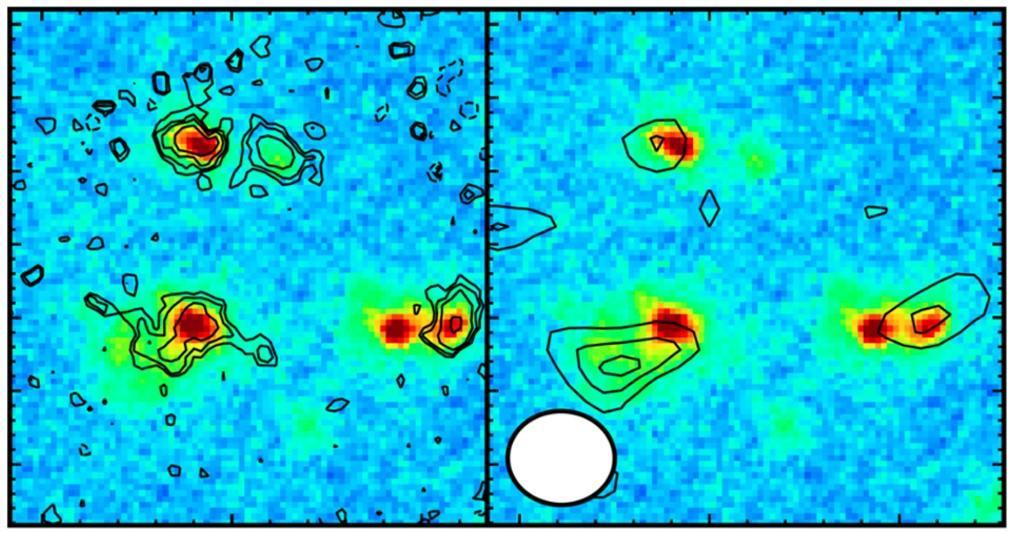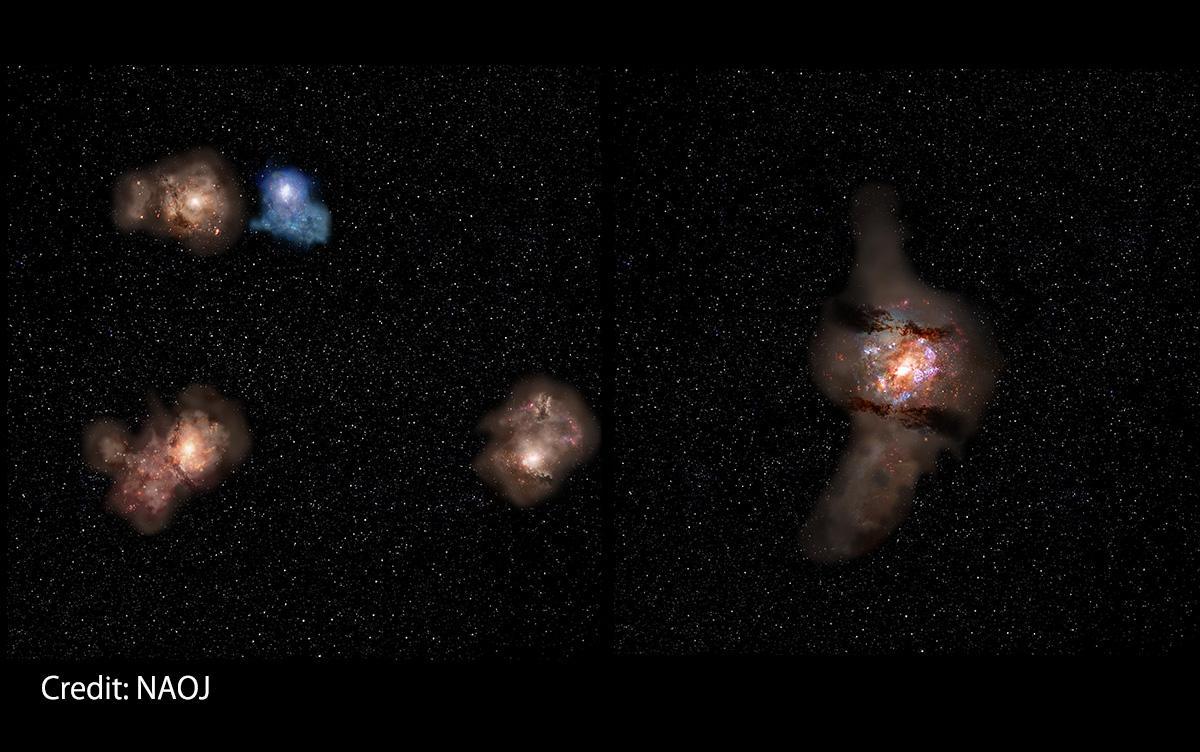The James Webb Space Telescope, ALMA capture the core of the most distant galaxy protocluster

 An international team of researchers, led by Assistant Professor Takuya Hashimoto from the University of Tsukuba in Japan and Researcher Javier Álvarez-Márquez from El Centro de Astrobiología (CAB, CSIC-INTA) in Spain, has used the James Webb Space Telescope and the Atacama Large Millimeter/submillimeter Array to observe the most distant galaxy protocluster to date, located 13.14 billion light-years away. The team has successfully captured the "core region" of the galaxy protocluster, which corresponds to a metropolitan area with a particularly high number density of galaxies. They discovered that many galaxies are concentrated in a small area and that the growth of galaxies is accelerated in this region. Additionally, the team used supercomputer simulations to predict the future of this metropolitan area and found that the region will merge into one larger galaxy in tens of millions of years. These findings are expected to shed light on the birth and growth of galaxies.
An international team of researchers, led by Assistant Professor Takuya Hashimoto from the University of Tsukuba in Japan and Researcher Javier Álvarez-Márquez from El Centro de Astrobiología (CAB, CSIC-INTA) in Spain, has used the James Webb Space Telescope and the Atacama Large Millimeter/submillimeter Array to observe the most distant galaxy protocluster to date, located 13.14 billion light-years away. The team has successfully captured the "core region" of the galaxy protocluster, which corresponds to a metropolitan area with a particularly high number density of galaxies. They discovered that many galaxies are concentrated in a small area and that the growth of galaxies is accelerated in this region. Additionally, the team used supercomputer simulations to predict the future of this metropolitan area and found that the region will merge into one larger galaxy in tens of millions of years. These findings are expected to shed light on the birth and growth of galaxies. 
The study of individual stars' birth and death in galaxies, the birth of new stars from remnants of old ones, and how galaxies grow are important themes in astronomy. They provide insight into our roots in the Universe. Galaxy clusters, one of the largest structures in the Universe, are composed of more than 100 galaxies bound together by mutual gravitational force. Observations of nearby galaxies have shown that the growth of a galaxy depends on its environment. For instance, mature stellar populations are commonly observed in densely collected regions of galaxies. This phenomenon is referred to as the "environment effect." However, it is not well known when the effect first occurred in the history of the Universe. A key to understanding this is observing the ancestors of galaxy clusters soon after the Universe's birth, which are known as galaxy protoclusters or protoclusters. These assemblies consist of about ten distant galaxies. Fortunately, astronomy allows us to observe the distant Universe as it was in the past. For instance, light from a galaxy 13 billion light-years away takes 13 billion years to reach Earth. Therefore, what we observe now is what that galaxy looked like 13 billion years ago. However, light that travels 13 billion light-years becomes fainter, so telescopes that observe it must have high sensitivity and spatial resolution.
A team of researchers led by Assistant Professor Takuya Hashimoto from the University of Tsukuba, Japan, and researcher Javier Álvarez-Márquez from the Spanish Center for Astrobiology used two powerful telescopes, the James Webb Space Telescope (JWST) and the Atacama Large Millimeter/submillimeter Array (ALMA), to study the "core region" of the protocluster A2744z7p9OD. This cluster had been hailed as the most distant proto-cluster at 13.14 billion light-years away based on observations with the JWST by another group of researchers. However, Hashimoto's team discovered that they had not studied the entire core region, which is the metropolitan area with the largest number of galaxy candidates in this protocluster. It was unclear whether the environmental effects of galaxies had begun in this protocluster. Therefore, the team decided to focus their research on the core region. "We wanted to determine if the environmental effects of galaxies had started in the protocluster. Our study will help us better understand the formation and evolution of galaxies in the early universe," said Hashimoto.
During their research, the team utilized the JWST to observe the core region of a protocluster. They used an instrument called NIRSpec, which can observe spectra at wavelengths ranging from visible to near-infrared, to conduct integral field spectroscopy observations. This allowed them to simultaneously acquire spectra from all locations within the field of view. The team was able to detect ionized oxygen-ion light ([OIII] 5008 Å) from four galaxies in a quadrangle region measuring 36,000 light-years along a side. This is equivalent to half the radius of the Milky Way galaxy (Figure 2). The distance of the four galaxies from the Earth was identified as 13.14 billion light years based on the redshift of this light (the elongation of the wavelength due to cosmic expansion). "I was surprised when we identified four galaxies by detecting oxygen-ion emission at almost the same distance. The 'candidate galaxies' in the core region were indeed members of the most distant protocluster," says Yuma Sugahara (Waseda/NAOJ), who led the JWST data analysis.
The research team paid attention to the archival ALMA data, which had already been acquired for this region. This data captures radio emissions from cosmic dust in distant galaxies. After analyzing the data, they were able to detect dust emissions from three out of four galaxies in this region. This is the first time that dust emission has been detected in member galaxies of a protocluster this far back in time. Cosmic dust in galaxies is thought to be supplied by supernova explosions at the end of the evolution of massive stars, which provide material for new stars. Therefore, the presence of large amounts of dust in a galaxy indicates that many of the first-generation stars in the galaxy have already completed their lives and that the galaxy is growing. Professor Luis Colina from El Centro de Astrobiología (CAB, CSIC-INTA) describes the significance of the results: "Emission from cosmic dust was not detected in member galaxies of the protocluster outside the core region. The results indicate that many galaxies are clustered in a small region and that galaxy growth is accelerated, suggesting that environmental effects existed only ~700 million years after the Big Bang."
Additionally, the research team conducted a galaxy formation simulation to test how the four galaxies in the core region formed and evolved. The results showed that a region of dense gas particles existed around 680 million years after the Big Bang. The simulation also showed that four galaxies were formed, similar to the observed core region. To follow the evolution of these four galaxies, the simulation calculated physical processes such as the kinematics of stars and gas, chemical reactions, star formation, and supernovae. The simulations showed that the four galaxies merge and evolve into a single larger galaxy within a few tens of millions of years, which is a short time scale in the evolution of the Universe. Yurina Nakazato, a graduate student at the University of Tokyo who analyzed the simulation data, says "We successfully reproduced the properties of the galaxies in the core region owing to the high spatial resolution of our simulations and the large number of galaxy samples we have. In the future, we would like to explore the formation mechanism of the core region and its dynamical properties in more detail."
Javier Álvarez-Márquez from the Spanish Center for Astrobiology says, "We will conduct more sensitive observations of the proto-cluster A2744z7p9OD with ALMA to see if there are any galaxies that were not visible with the previous sensitivity. We will also apply the JWST and ALMA observations, which have proven to be very powerful, to more protoclusters to elucidate the growth mechanism of galaxies and explore our roots in the Universe."
The James Webb Space Telescope and ALMA have proven to be a powerful combination in exploring the universe. Their joint effort has enabled us to capture the core of the most distant galaxy protocluster ever discovered, providing us with a glimpse of the earliest stages of galaxy formation. This remarkable achievement is a testament to the power of human ingenuity and collaboration and serves as a reminder of the potential of science and technology to unlock the mysteries of the cosmos. With the continued development of these two powerful tools, we can look forward to even more remarkable discoveries in the future.

 How to resolve AdBlock issue?
How to resolve AdBlock issue?